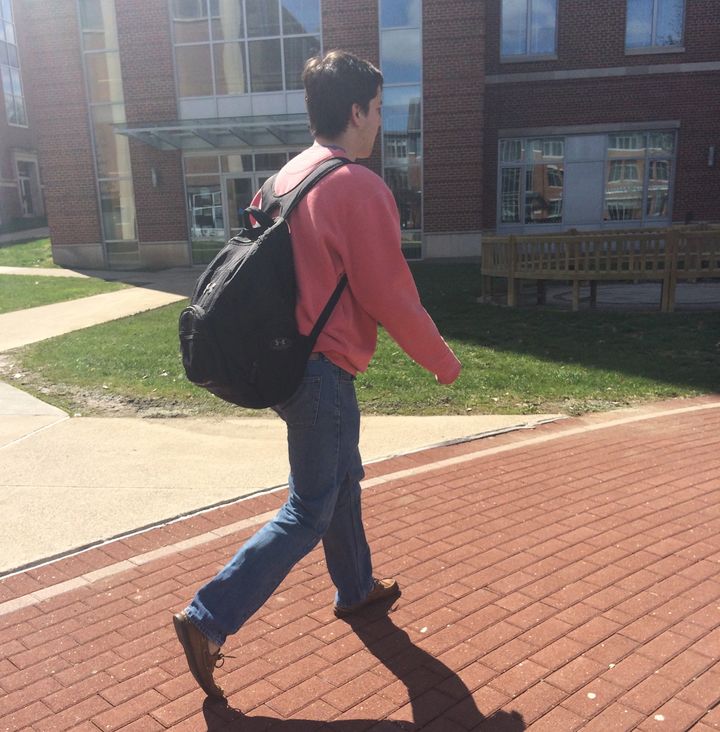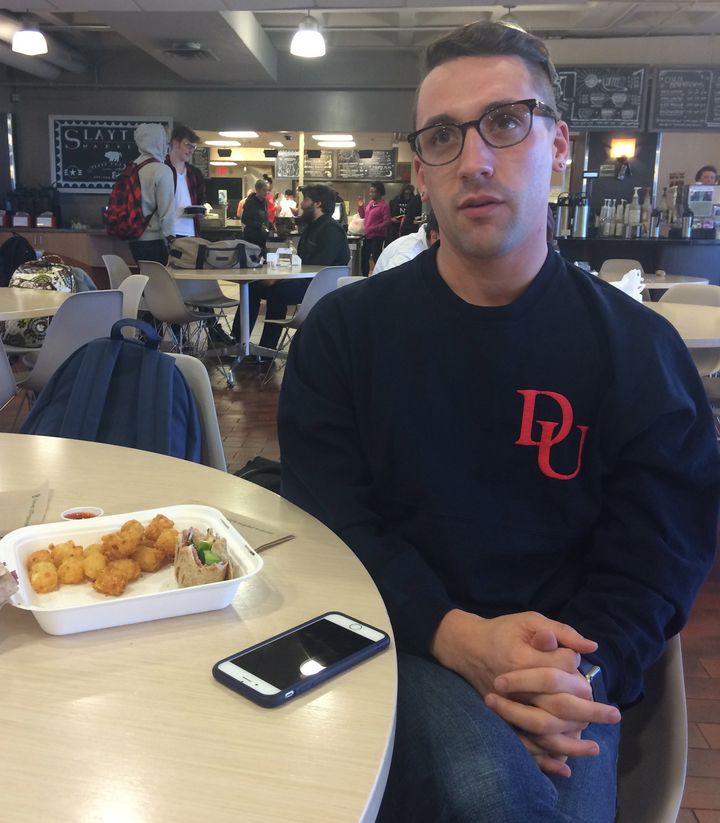
GRANVILLE, Ohio — When Laurel Kennedy, a communications professor, arrived at Denison University more than 25 years ago, she remembered seeing a sea of white, blond-haired students. “Now there is much more diversity in every way,” said Kennedy. “Now we have students with blue hair.”
The college now has more students from various racial, ethnic and family-income backgrounds, too. But after working hard to create a more diverse campus, reflective of the world beyond college, Denison recently decided that its diversity would be as cosmetic as blue hair if students didn’t experience it by interacting with each other.
“The best decisions are made by diverse teams of people,” said Denison President Adam Weinberg. “How do we move from a place that has become diverse to a place that really embraces diversity as a core value and as a community strength?”
To motivate students to engage with those different from them, school leaders are looking at everything from the way they fund activity groups to the size of party venues to the physical layout of the campus.
“Cultural change always lags behind demographic change,” said Kennedy, who is now vice president of student development. “It’s harder to change the culture than it is to change the composition of the student body.”
Denison has just over 2,000 students. The school began pushing to increase its diversity 15 years ago, offering more loans and doing outreach to urban high schools. According to school administrators, in 2005-06, 16 percent of the student body was considered multicultural, which Denison defines as African-American, Native American, Asian-American, Hispanic, multiracial or international. By 2014-15, 32 percent was multicultural. Similarly, in 2005 there were 257 recipients of Pell Grants, the federal grants that go to low-income families. That number rose to 444 in 2014-15.
“Denison is in a really unique spot. We have the diversity. We are now figuring out how to talk to each other."”
- Brian Allen, a gay student at Denison
Two years ago, administrators created a $5,000 pool to encourage different groups to work together. Called the Fund for Campus Innovation and Action, it provides students up to $500 per project to execute ideas that will better integrate students and foster communication between all groups. For instance, one proposal from a student was to make dinner for guests from different groups, the goal being to get a variety of students to share a table and bread. The money was for groceries.
A group of athletes, the Diversity and Inclusion Athletic Advisory Group, received money to create cards to be distributed on campus, on which 10 athletes wrote about words they would never use. One card, featuring a picture of a female swimmer, read, “Saying ‘Oreo’ insists that I act in accord with racial stereotypes. I don’t.” Another card, with a picture of two golfers, male and female, read, “Transphobia is harmful, so we embrace all gender identities.”
The school also provided funding for a monthly story slam at the campus coffee house. One theme asked students to describe their first love. “It gave us a lens into someone else’s experience, which builds empathy,” said Haley Wells Jones, a junior who organized the event.
Not all projects got the green light: A proposal to start a small band to boost school spirit was rejected.

At the same time, student government, which has a hefty budget for student activities of nearly $900,000 (a lot of the money goes to guest speakers), changed the way it funded groups, giving priority to those that co-host events with other, different groups. For instance, the Black Student Union hosted an event with an LGBT group.
Administrators also began looking at physical and architectural ideas. “Bringing students together in all kinds of spaces feels really important,” said Kennedy. “It’s this really interesting question of how can you design space so that you encourage and facilitate interactions across lines of difference? What would that space look like?”
“My posse broke down and cried when I said I was coming here. They said [whites] 'will disrespect you.'"”
- Devonta Dickey, a Denison University senior
Denison has an aesthetically beautiful campus with plenty of green space — it covers 900 acres, more than half of which is a biological reserve, and was designed by Frederick Law Olmsted. Pedestrian paths link the buildings, amid thick oak and elm trees and well-manicured lawns. Yet students zip around, rarely stopping to sit and soak in the possibility of a chance encounter with classmates. The flagpole outside the student union, which faculty and students agree is the campus gathering point, has benches about 20 feet across from each other, meaning students would have to shout to converse.
Weinberg, whose academic background is in sociology, has organized a team that is looking to alter the landscape to encourage student interaction through steps such as adding moveable seating (like Adirondack chairs or beanbags) and installing artworks.
In addition, many students told Weinberg that it was a challenge to include several groups at a party because most of the school’s recreational facilities can only accommodate about 40 students at a time. As a result, he said, the school is considering adding a barn to campus where students could hold events like dances for 100 or more students.
When Weinberg became president three years ago, he was surprised by the range of Denison’s diversity, saying that the students represent a mix of races, ethnicities, classes, political beliefs and religions. “I saw lots of challenges, but I also saw real opportunity,” he said.
The size of the campus, he added, makes cultural integration doable: “At a large state school, you can avoid people different from yourself. At a residential college of 2,000 students, everyone is bumping up against each other.”
Still, students fear some of their counterparts will remain tough to reach.
“In 2005-06, 16% of students at Denison were considered multicultural; by 2014-15, 32% were. Similarly, in 2005 there were 257 recipients of Pell Grants, which go to low-income families; that number rose to 444 in 2014-15.”
Jewell Porter, a senior and a member of the Black Student Union, noted that when the school held a screening of “More Than a Noose,” a film about how the campus reacted to a student arts group that used a noose on a flyer to promote an event in 2007, turnout was strong but it was familiar faces.
“The students who need to be there aren’t there, and that’s what makes it difficult to deal with race relations on campus,” she said. “If the students don’t want it to happen, it’s not going to happen. It’s not just a Denison problem, it’s a problem we see everywhere.”
Kennedy sympathized, but added, “We can’t use that as a reason not to meet and have a conversation, because the conversations move us forward.”
When Porter arrived at Denison, she was comfortable making friends with white students, she said, because she had gone to a predominantly white high school. But there were still hurdles, like when she felt singled out by a speaker who was discussing slavery, and when her white friends did or said things that made her cringe, such as “thinking they can freely say the N word, or touching my hair like it’s a petting zoo.”
“Most of the time it’s not meant maliciously, so you just need to point it out,” she said. “I was really uncomfortable doing that, but as my college career went on I felt more comfortable doing that.”

Likewise, Brian Allen, a gay swimmer from Flagstaff, Arizona, recalled a teammate saying, “That’s so gay.” Allen said he replied, “ ‘You are talking about one of your brothers. Everyone on the team should feel safe.’ The culture changed significantly once I set the ground rules.”
While he felt at home with his swim team family, he said, he had a harder time finding a gay community, something he found easily in Flagstaff.
He wasn’t the only one who struggled with the differences between home life and the Denison community.
“My posse broke down and cried when I said I was coming here. They said [whites] ‘will disrespect you,’ ” said Devonta Dickey, a black student from Chicago. He told his hometown friends, “Don’t discriminate,” but admits he shared their concerns. However, since being on campus, he said, he hasn’t experienced discrimination or disrespect.
“If the students don’t want [integration] to happen, it’s not going to happen. It’s not just a Denison problem, it’s a problem we see everywhere.””
- Jewell Porter, a Denison University senior
Despite challenges, the students interviewed said they feel safe talking about issues of diversity and discontent with fellow students and faculty.
“Denison is in a really unique spot,” said Allen, the swimmer. “We have the diversity. We are now figuring out how to talk to each other.”
Weinberg said he’s noticed a change in the last two years. “I go to home athletic events and arts events. I look at who is talking to who, and who walks in,” he said, adding that he sees athletes going to art events, and vice versa. “I’ve seen huge changes in the last 24 months.”
De’Von Fulton, a freshman from the suburbs of Chicago, said he was drawn to the campus because of its diversity and welcomes any chance to learn about a new culture. “I’m the Shabbat coordinator for Denison,” said Fulton, a Christian. A Jewish friend volunteered him for the job because he likes to cook, he explained. “I said ‘Why not?’ I make a great kugel.”
Amanda Peiffer, a senior who is a member of Outlook, an organization that supports Gay, Lesbian, Bisexual, Transgender, Questioning and Allied (GLBTQA) concerns, said she struggled to understand her dorm mates in Greek life. But instead of complaining about their parties, she asked a fraternity to host one with Outlook. “It was the coolest thing to see these super frat guys mingle with these super queer guys,” she said. “It was chiseling away at that barrier.”
______
This story was produced by The Hechinger Report, a nonprofit, independent news organization focused on inequality and innovation in education. Read more about Higher Education.